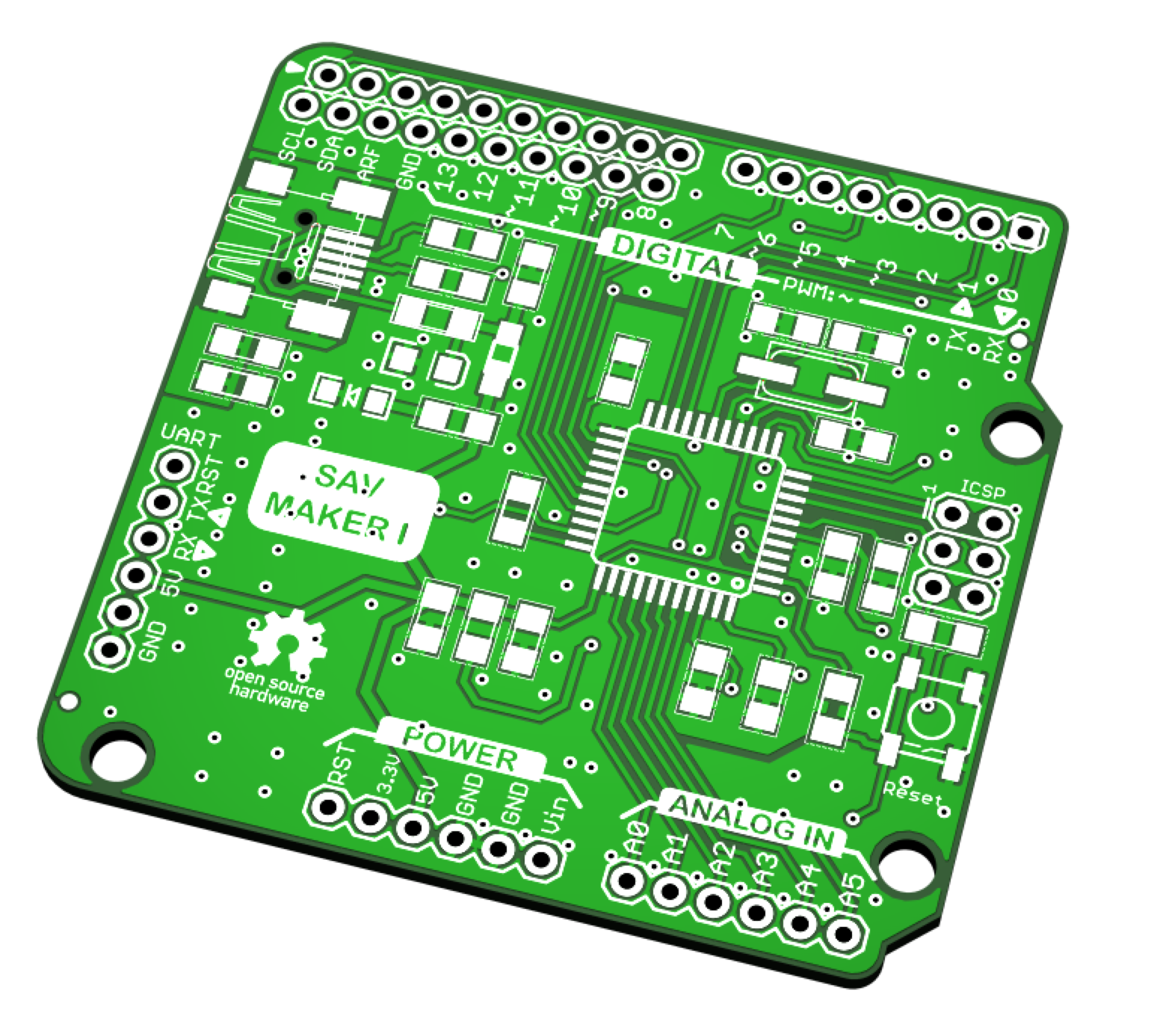-
Notifications
You must be signed in to change notification settings - Fork 11
Specifications
The SAV MAKER I has the same form factor and connectors as the Arduino Pro, however it uses a different processor, the Atmega32u4. This chip has the same features of the Atmega328 (used in UNO) with the added benefit of having built in USB.

- Microcontroller: ATmega32U4
- Operating Voltage: 5V
- Input Voltage (recommended): 5V
- Digital I/O Pins: 14 (of which 6 provide PWM output) + 6 (analog pins)
- Analog Input Pins: 6
- DC Current per I/O Pin: 40 mA
- DC Current for 3.3V Pin: 50 mA
- Flash Memory: 32 KB (-2KB bootloader)
- SRAM: 2,5 KB
- EEPROM: 1 KB
- Clock Speed: 16 MHz
The SAV MAKER I can be powered via the USB connection or with a 5V external power supply. The power source is selected automatically. External (non-USB) power can come either from an AC-to-DC adapter (wall-wart) or battery. The adapter can be connected to its supply pins or via USB. Leads from a battery can be inserted in the Gnd and 5V pin headers of the POWER connector.
- VIN. Not used.
- 5V (in or out). The regulated power supply used to power the microcontroller and other components on the board. This can be used as a voltage input or output, depending on how you are sourcing power to the board.
- 3V3 (out). Are derived from the on chip regulator and accessible through the 3.3V pin. This pin will only supply up to 50mA (25 mA when the usb is in use).
- GND. Ground pins.
###Memory The ATmega32U4 has 32 KB. It also has 2,5 KB of SRAM and 1 KB of EEPROM (which can be read and written with the EEPROM library).
Each of the 14 digital pins on the SAV MAKER I can be used as an input or output, using pinMode(), digitalWrite(), and digitalRead() functions. They operate at 5 volts. Each pin can provide or receive a maximum of 40mA and has an internal pull-up resistor (disconnected by default) of 20-50 kOhms. In addition, some pins have specialized functions:
- Serial: 0 (RX) and 1 (TX). Used to receive (RX) and transmit (TX) TTL serial data. Broken out on UART header too.
- External Interrupts: 2 and 3. These pins can be configured to trigger an interrupt on a low value, a rising or falling edge, or a change in value. See the attachInterrupt() function for details.
- PWM: 3 (8bits), 5 (8bits), 6 (FastPWM), 9 (16bits), 10 (16bits), and 11 (8/16bits). Provide PWM output with the analogWrite() function.
- SPI: Dedicated ISP conector: 14 (SS), 16 (MOSI), 17 (MISO), 15 (SCK). These pins support SPI communication using the SPI library.
The SAV MAKER I has 6 analog inputs, labeled A0 through A5, each of which provide 10 bits of resolution (i.e. 1024 different values). By default they measure from ground to 5 volts, though is it possible to change the upper end of their range using the AREF pin and the analogReference() function.
- AREF. Reference voltage for the analog inputs. Used with analogReference().
- TWI: Dedicated pins SDA and SCL. Support TWI communication using the Wire library. Pins are shared with IO 2 and 3.
- SPI: ICSP header for programming and SPI operation.
- Reset. Bring this line LOW to reset the microcontroller. Typically used to add a reset button to shields which block the one on the board.
The SAV MAKER I has a number of interfaces for communicating with a computer, with another Arduino, or other microcontrollers.
The ATmega32U4The provides UART TTL (5V) serial communication, which is available on digital pins 0 (RX) and 1 (TX), or through the dedicated header connector.
The built-in USB controller channels this serial communication over USB and appears as a virtual com port to software on the computer. The 32U2 firmware uses the standard USB COM drivers, and no external driver is needed. However, on Windows, a .inf file is required. The Arduino software includes a serial monitor which allows simple textual data to be sent to and from the Arduino board.
A SoftwareSerial library allows for serial communication on any of the SAV MAKER I’s digital pins.
The ATmega32U4 also supports I2C (TWI) and SPI communication. The Arduino software includes a Wire library to simplify use of the I2C bus; see the documentation for details. For SPI communication, use the SPI library.
Rather than requiring a physical press of the reset button before an upload, the SAV MAKER I is designed in a way that allows it to be reset by software running on a connected computer.
You may also be able to disable the auto-reset by connecting a 10uF Capacitor from Reset line to GND.
The SAV MAKER I has 2 resettable polyfuse that protects your computer’s USB ports from shorts and over-current. Although most computers today provide their own internal protection, the fuse gives you that extra layer. If more than 500 mA is required, the fuse will automatically break the connection until the short or overload is removed.

